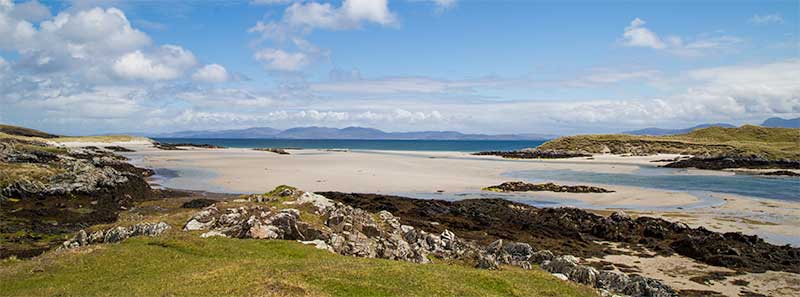Ancient history, clans and wildlife, on Oronsay, the smallest island in Scotland
Oronsay has furnished archaeologists with invaluable information about the Mesolithic period of prehistory, particularly about the diet of human beings for years. Three middens (waste tips) opened in the 1880s and have provided a piece of bone carbon-dated to 4600 BC and an oyster shell to 3065 BC. Evidence provided from saithe bones in the middens suggest that the local population lived there all year round and heavily reliant on marine protein. By the close of the Iron Age around 500 AD, Oronsay was part of the Gaelic-speaking Kingdom of Dál Riata although which of the main Dalriadan clans controlled them is unknown. In the 6th century, Columba landed here on his initial journey from Ireland to Iona, but continued onwards when he discovered he could still see Ireland from the summit of Beinn Orasaigh. The site of a Norse ship burial has been found on Oronsay dated to the mid 9th century at which point these islands were likely part of the far-flung Kingdom of the Isles. Following the 1266 Treaty of Perth the Hebrides were yielded to the Kingdom of Scotland and the Gaelic language re-asserted its dominant position in the southern Hebrides. Oronsay also had a medieval Augustinian priory, the ruins of which are still extant. It was built c. 1380, possibly on the site of the sixth century forerunner, perhaps founded by John of Islay, Lord of the Isles (Macdonalds). Two Celtic crosses sit outside the perimeter of the building and many slabs with effigies or other carvings are still to be found within the priory itself.
After the Scottish Reformation in 1560, the lands and property of the priory was given to Maol Choluim MacDubhthaich (Malcolm MacDuffie), at which time it would appear that the community ceased to exist. The MacDuffies based their operations at the site of the old Dalriadan fort of Dun Eibhinn. Writing in 1549, Sir Donald Monro, High Dean of the Isles stated of “Orvansay” that it was a low-lying island with “ane Monasterie of Channonis” and “full of hares and polecats, with a good anchorage for Highland galleys and shallow waters”. In 1596 a report about the military strength of the Lords of the Isles indicated that Colonsay and Oronsay together maintained a contingent of 100 warriors who were not required to work the land. By the early 17th century land on Colonsay was held by both Clan Macfie and Clan MacDonald of Dunnyveg (Islay). In 1623 Coll Ciotach (Colkitto), an Irish Dunnyveg mercenary, was charged with the murder of Malcolm MacFie. MacFie had been hiding on Eilean nan Ròn (an islet south-west of Oronsay) but he was spotted there by Colkitto’s men, apprehended and then tied to a stone and shot. Colkitto held the whole of Colonsay and Oronsay from the Campbell Earl of Argyll. However, not long after this Colkitto lost his own life in the Wars of the Three Kingdoms and by 1701 the Campbells had sold both islands to a MacNeill of Knapdale, whose family held these lands until the early 20th century.
Oronsay is four miles in circumference, being for the most part a plain arable; it has a church, chapel, and monastery. There are several burial places there, the tombstones have a two-handed sword engraved on them. On the south side of the church within lies the tomb of MacDuffie; a ship under sail and a two-handed sword engraved on the principal tombstone and the inscription, Hic jacit Malcolumbus MacDuffie de Collonsay; his coat of arms and colour-staff is of red in a stone, through which a hole is made to hold it. Oronsay today is a small, privately owned (tidal) island to the south of Colonsay in the Inner Hebrides. With an area of just over 2 square miles it is connected to Colonsay by a tidal causeway known as The Strand and having no facilities of its own, it is entirely dependent upon its tidal access to and from Colonsay. I have driven from one island to the other at low tide, in a 4×4.
The island is best known for the Priory, a 14th century Augustinian ruin, probably on the same site as the original, founded in 563 by St Oran. Oronsay beach became a Special Protection Area in December 2007 in order to preserve their resident populations of choughs and breeding corncrakes. The tiny Seal Cottage stands alone overlooking the sands, grey seals can often be seen in the water and rocks here. The views across to Jura and the Paps are fab.
WANT TO VISIT? WE CAN ARRANGE IT mcleanscotland.com

